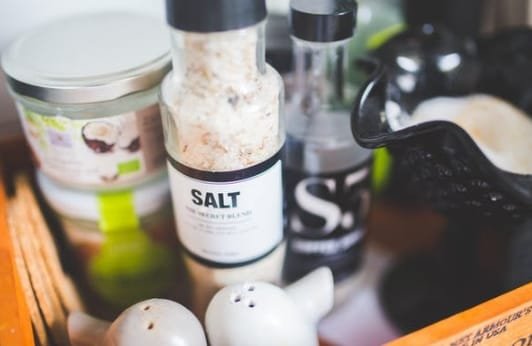
by admin | May 30, 2022 | Fitness
Reasons You’re Not Losing Weight
Losing weight is hard. We get it. But sometimes it seems like no matter what you do, the number on the scale just refuses to budge. You might be doing everything “right,” but still not seeing results. Don’t worry – you’re not alone. Many people struggle with weight loss, even when they’re following all the right steps. So what’s going on? Let’s take a look at some of the most common reasons you’re not losing weight…
You’re Not In A Caloric Deficit

Now, the first and primary reason you’re not losing weight, is that you are not eating in a caloric deficit! Eating less food than your body requires to maintain its body weight is the most fundamental principle of weight loss, which you can’t get around. Not with fasted cardio. Not with keto. Not with morning workouts.
If you’re not eating in a deficit, you won’t lose weight. Simple as that. “But I was counting my calories and still, the number on the scale didn’t move even a tad bit!” Well, that simply means you are not in a deficit! Remember that calorie calculators give just an approximate number and more often than not, people tend to overestimate their activity levels or underestimate their caloric intake, leading to an energy balance different than what the calculator says is a ‘deficit’.
So stick to the weight scale and aim to lose up to 1-2 lbs per week.
You’re Snacking Too Much

In fact, not eating in a deficit is the only reason why you aren’t losing weight, but the truth is that there are many other things (reasons) that can keep you away from eating in a deficit. The second most common one is that most people on a diet snack too frequently.
And that’s normal, because eating in a deficit inevitably increases your cravings for certain foods, and you start snacking more often, somewhat unconsciously. This leads to an extra couple hundred calories that get you back to your baseline caloric intake, and out of a caloric deficit.
You’re Slacking!
Losing weight is demanding on both the mind and the body. Oftentimes, people on a diet feel like they’ve done a good job for a couple of days in a row and then cut themselves some slack, as a form of a ‘reward’ for their work well done. During these periods, those same people would lose track of their plan and indulge in a variety of foods.
And the truth is that even one or two days of slack can totally ruin a week of hard work, especially, if you’re eating in a surplus. So, remember to always stay on track!
You Are Not Active.
Last but not least, most people are simply not active enough to have a caloric deficit become an easy task! Let’s be real here for a second – The modern-day lifestyle is too sedentary! At best, people on a weight loss diet will go to the gym for an hour, a couple of times a week. Pair less activity with an abundance of food and there you have it – You are out of a deficit and deep into a surplus again!
Final Thoughts
The next time you’re tempted to blame your slow weight loss on a “slow metabolism,” remember that there’s just one factor at play – Whether or not you are in a caloric deficit! So here’s our best advice – Stay active, eat satiating foods, avoid excessive snacking, and don’t slack!
Stick to the basics.

by admin | May 30, 2022 | Diet
Reverse Dieting – How To Keep Your Metabolism Fast
When the quest at hand is achieving a normal body composition (normal ratios of fat and muscle), dieting in order to lose the excess fat is inevitable. However, a frequent occurrence after a period of weight loss, is the weight gain rebound. This is often known as “Yo-Yo dieting” and it basically leads to gaining all the weight back in twice as less time as it took to lose it.
In this article, we’re going to give you valuable insight on how to keep the weight off after a diet, with one simple method – Reverse dieting!
Now let’s get to it.
Why Does The Rebound Happen?

Though you may associate weight loss with better looks and feeling better in your own skin, a diet really means starvation for the body. The more weight you lose, the more you’re priming your fat-storing mechanisms, because the body perceives the deficit of energy as a period of starvation, as we just said. Since the body gets less calories from food than it is used to, metabolic adaptations start happening.
In simple terms, this means that the body slows down the metabolism and what was once a caloric deficit becomes your maintenance calories.
The more time you spend on a diet, the more you have to decrease food.
So, How Can You Counter This?
If you want to preserve your metabolic rate, there are a couple of things you can do, one during the diet and one in the period after the diet.
Those two things are:
- Diet breaks
- Reverse dieting
Diet Breaks

Though it may sound quite misleading, diet breaks are periods during your diet, when you bump up your calories back to baseline, maintenance level. This helps your body keep the metabolic rate up and thus, prevents the risk of excessive caloric decrease. Now of course, a diet break doesn’t really mean you can ditch the diet and totally go crazy on your food consumption. Again, a diet break is simply a period where you consume slightly more food, in amounts that won’t lead to drastic changes in weight.
Diet breaks are best implemented every couple of weeks, for a couple of weeks. For instance, if you’ve been consistently losing weight for 2-3 weeks, you can afford to have a 2-3 week diet break, during which you’ll consume at maintenance and train with a slightly higher intensity.
Though this will make the total time dieting longer, it will minimize the risk of a weight gain rebound.
Reverse Dieting
After your diet is over and you reach your desired shape, you can’t just ditch everything altogether. You have to understand that keeping the weight off is a matter of sticking to the same habits that helped you lose it in the first place.While dieting implies a gradual decrease in your caloric intake overtime, reverse dieting is, well, the exact opposite!
After your diet is over, it is time to gradually bump up your calories and training intensity. This will help you increase your food intake, WITHOUT risking a weight gain rebound. The goal of a reverse diet is to help you increase your food consumption, without drastic changes in weight.
To do so, follow these simple steps:
- Each week, increase your calories by 50-80 (Stacks up to ~400 extra calories in 5 weeks)
- Workout to workout, increase your working weight, sets and repetitions
- Stay consistent
Just like your dieting phase, during the reverse dieting phase you have to still monitor your weight and if there are sudden changes, adjustments should follow. (i.e if you’re losing more and more weight, you should bump up food intake and vice versa – if you’re gaining too much weight, food intake should be decreased)
Conclusion
In many cases, reckless dieting leads to unwanted weight gain rebounds, that make all your hard work worthless. To avoid this, you have to make sure that your deficit is not overly aggressive (up to 500 calories per day), while also including dieting breaks every 2-3 weeks of being in a caloric deficit.
After your diet is over, you should gradually increase your caloric intake and training output, while monitoring your weight and adjusting the diet as needed. Ultimately, sustainable weight loss is a slow, gradual process which is supported with proper habitual changes, sustained even after the diet is over.

by admin | May 30, 2022 | Health, General
Salt How Much Is Too Much?
Besides carbohydrates, salt has been one of the nutrients in food that has taken a big punch to the face, being often demonized. And though excessive consumption of salt can lead to unwanted side effects, facts remain facts – Salt is a VERY important micronutrient for the body. As a matter of fact, salt provides sodium, which is tightly regulated in the body, meaning that if you have too little, you won’t excrete as much and vice versa – if you have too much, you will excrete more.
In this short article, we’ll tell you more about salt, its functions, roles and recommended daily intake.
What Is Salt?

Salt is essentially made up of sodium & chloride, which are both essential microelements for the body that serve a variety of functions. Salt can be found in certain foods but is widely available in the form of crystals, which is in fact, the main reason why some people over consume it.
What Are The Functions Of Salt?
The main contents of salt (sodium & chloride) both play roles in many of the vital functions of the human body.
Those functions include but are not limited to:
- Carrying nerve impulses
- Muscle contraction
- Fluid balance
One fun fact is that chloride molecules help the body maintain the alkaline-acidic balance, thus helping sodium serve all of its functions properly.
What Is The Daily Recommended Intake?

Now, the good part is that the body has learned how to be efficient with its micronutrients, throughout the millions of years of evolution. Therefore, the body’s sodium needs are not sky high as one may think – those vary from 2 to 4 grams of salt per day. For kids under the age of 10, as well as adults above the age of 65, the daily needs may drop even further.
According to the world health organization, the upper limit for salt intake is around 5 grams, which is equal to about one teaspoon.
Side Effects Of Excessive Salt Consumption
With excessive sodium consumption, it is possible that the kidneys will not be able to excrete the excess amount and thus, levels of sodium in the blood rise. Sodium then binds with water and the total blood volume is increased, leading to an increase in blood pressure. If sustained, high blood pressure can have a lot of consequences for your health, including but not limited to:
- Insult
- Aneurysm
- Worsened kidney function
- Kidney stones
- Cardiovascular problems
Which Foods Contain Salt?
As we mentioned, there are many foods that contain a lot of salt, but those are mostly processed/canned foods.
Such are:
- Canned fish/meats
- Pickles
- Chips
- Instant foods
- Soy sauce
Most natural foods however, such as grass-fed beef, have a naturally low sodium content, putting them in the category of the safest foods to consume. These are the products you should focus on in your nutrition plan, while avoiding any highly processed foods as the ones mentioned above, for the most part.
Take Home Message
To wrap this up, let us tell you this – Salt is not the enemy. Carbs are not the enemy. Fats are not the enemy. The REAL enemy is the lack of balance and the lack of knowledge about what the body actually needs. Salt in and of itself is an ESSENTIAL nutrient, without which you will not function optimally, both physically and mentally.
For this reason, your best bet is to test for yourself and see which amount of salt daily is most suitable for your own activity levels. Some people may feel just fine at 2 grams, while others may need to go up to even 5-6 grams (i.e people who move and sweat a lot). For this reason, you should take all this information with a grain of salt and test for yourself!
Stay safe.

by admin | May 30, 2022 | Fitness
How To Lose Weight & Keep It Off | Part 2 – Training
Training during the weight loss phase is one of the most important factors to consider if your goal is to lose weight healthily. One important mention is the fact that during a period of weight loss, you lose not only fat, but lean body mass as well. This includes muscle tissue, organ tissue, bone tissue and technically everything else except fat.
Why you SHOULD Train During Weight Loss

Carefully managing your weight loss period across the aspects of nutrition and training is essential for minimizing those lean body mass losses. Especially when it comes to training, this is what will actually give a reason to the body to retain its muscle mass. Think of it this way – If you use the muscles, that directly tells the body “we’re going to need this!”.
This in turn will favor muscle protein synthesis and when paired with good nutrition, it will also minimize muscle protein breakdown. The end result? A healthier period of weight loss, during which you have increased mood and energy for all your physical and mental activities. Now let’s see the MOST IMPORTANT considerations when approaching training.
What type of training should you choose?
Generally, when it comes to training for fat loss, many people think of extensive, low-intensity cardio sessions. And though that type of exercise helps you burn more energy and make it easier to create a caloric deficit, it is not optimal for the retention of lean body mass. Resistance training is one of the BEST tools you can use for that purpose, but you can still add cardio sessions, after resistance training.
Overall, your goal with resistance training would be to train each muscle group once every 72-96 hours. Now let us tell you more about the separate aspects of your workout.
Training Intensity
During a period of weight loss, you subject yourself to a deficit of energy, meaning that you are below your body’s maintenance needs. This lesser amount of energy implies that you might have suboptimal recovery after a workout. However, that doesn’t mean you shouldn’t train it all, but rather, you should manage your training intensity.
Training at moderately high intensity can help you avoid suboptimal recovery and can be realized in a couple of ways:
- Use moderately heavy weights
- Don’t reach failure
- Don’t overexert
In doing all of this, you will ensure that there is a good stimulus, but also enough energy to recover from it.
Training Frequency

When you workout, you practically break down muscle proteins and then, re-build them to improve the performance and appearance of your muscles. Since recovery isn’t instant, you’d need to grant a sufficient time frame before training a given muscle group again. This would generally be around 48-96 hours, which would allow for good recovery and increased performance.
Training Volume

Besides training intensity and frequency, you also have to consider the number of sets and repetitions that you’ll be doing for each body part. For the general trainee, doing 5+ challenging working sets per muscle group trained in a workout, is the best approach, given that you exercise each muscle group twice a week.
The widely accepted effective training volume forms at 10-20 working sets, per muscle group, per week. Of course, if you are a beginner or intermediate, you will be in the lower range of that spectrum. The more you advance, the more you increase sets, reps, and weight.
When To Train?
Alright, you have a workout plan in place but what is actually the best time to train when the goal is losing fat? Will fasted training in the morning maybe produce more results? Well, at equated caloric deficits, training timing won’t make a big impact on total amount of fat lost, HOWEVER…
The more energy you have available before a workout, the better you will perform and thus, the better the end result will be. Furthermore, your body runs a biological cycle that is intricately connected with the Day & Night cycle of the Earth. As light goes through your eyes, it gives a signal to the brain, which in turn releases serotonin.
Serotonin makes you feel awake, alert & energized. By afternoon, you would already be a couple of meals into your day (plenty of energy), and will have a good amount of serotonin produced. If you look closely, the period between 2 and 5 pm is when you feel most alert and active.
Conclusion
Using resistance training as a tool to optimize your fat loss process, is one of the best practices for any individual looking to get fit. Your workouts should consist of a good number of challenging working sets, that should not be taken to failure, due to the fact you are in an energy deficit. Ultimately, your best bet would be to do these workouts in the afternoon, but this can be adjusted to your schedule.
Combining an adequate approach to training & nutrition will allow you to create sustainable results, that will give you health in your older years.

by admin | May 30, 2022 | Health, General
Self Mercy Vs Laziness – What’s the Difference
Many times, we get so occupied with work and responsibilities that we forget to take care of ourselves. When this happens, we attempt to find the time to cool off and pamper ourselves, which is where the concept of “self-mercy” comes in. However, some people believe this to just be used to justify laziness… For example, taking the weekend off work to binge your favorite Netflix movies as a form of self-love.
While this may be the case, oftentimes it is an excuse to procrastinate and be lazy. Though the line between self-mercy and laziness is thin, they are different concepts. Self-mercy is a necessity and should not be confused with laziness, so let us dive further into this.
What is Self-Mercy?

Self-mercy is taking care of oneself and showing yourself appreciation and compassion. It is the process of holding yourself in high regard and prioritizing your happiness and well-being. This is not about gratification as in laziness, rather it motivates you to maintain practices that are beneficial for your physical and mental wellbeing.
It is the perfect way to ease stress and stay productive.
How to Practice Self-Mercy
There is no standard rule for this, it all boils down to preferences and that which brings out your best. Do those things that spark your creativity, improve your mood and enhance your growth.
Here are some simple steps for you.
1. Identify Your Goals
Outline what you intend to achieve, as this will influence your ability to properly integrate self-mercy. Divide these goals into long-term and short-term and brainstorm activities that can move you towards them.
2. Make it a Habit
To become accustomed to self-mercy and make it effective, turn it into a habit. Incorporate it into your daily and weekly routine, and soon enough it becomes a part of you. Pace yourself and start small so you don’t get overwhelmed.
3. Pay Attention to Your Mind
Tune out all forms of distractions and listen to your body, it will inform you when it’s time for resting and pampering. (This is the purest form of self-mercy)
4. Remove Obstacles
You probably shy away from self-love because you believe it is exhausting. Understand that you deserve every form of kindness and find ways to make the process easier for yourself. You could find an accountability partner to help with this.
What is Laziness?

As stated earlier, it is easy to confuse laziness with self-mercy. Whereas self-mercy is a means to recharge for increased productivity, laziness is the act of avoiding tasks that you should be doing. It reduces motivation and hinders us from reaching our goals. If you still can’t differentiate the two, here are the signs of laziness.
1. Procrastination
When you procrastinate, you constantly put off priorities and focus on less important and non-beneficial tasks. This is a challenge faced by many people, and they waste time on unproductive things that prevent them from accomplishing their goals. A lack of self-discipline is one of the major causes of procrastination.
2. You Feel Guilty
Practice will make you know the difference between taking needed time off to recharge, and avoiding important tasks because you were not in the mood. The latter is laziness and will leave you with a sense of guilt because you wasted the time meant for more important activities, the time you will never get back. To avoid this, plan your self-mercy activities.
3. Feeling Fatigued
Doing nothing at all is a sign of laziness, you do not exercise, read, or do any other activity that can contribute to your growth. Instead, you stay indoors all day ignoring your assignments and things that do add value. It is easy to cross the line from just the appropriate amount of self-mercy time to getting fatigued from taking too much time off due to laziness.
Conclusion
Self-mercy is the innate ability to recognize the right moments to take a rest and recharge your batteries. Nevertheless, that does not mean completely relaxing and not doing anything productive, but rather, opening up time for active recovery. Self-mercy can be a challenge at first and may lead you to become lazy without you even realizing it, but once you’ve established a clear border between the two, your self-mercy will allow you to perform better mentally and physically.























